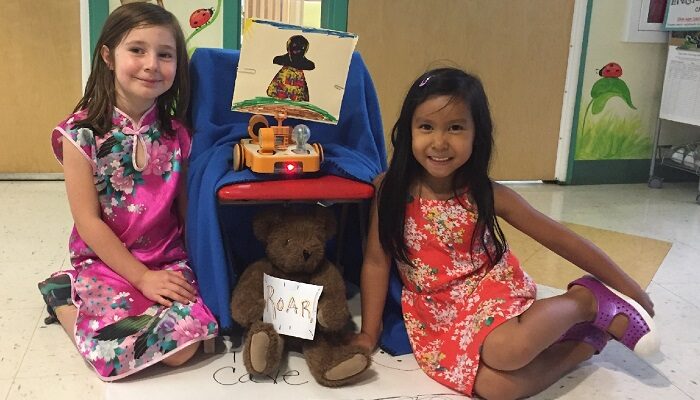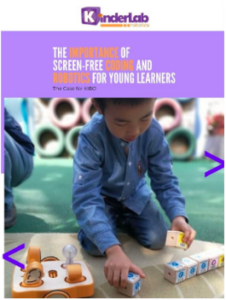Robotics in Early Childhood Education – Kindergarten Coding Teaches the Literacy of the 21st Century
In this new blog series, we share key reasons why early childhood educators should be incorporating Kindergarten Coding in their classrooms. In this blog, we are focusing on Key #1 – Coding Teaches STEAM, the Literacy of the 21st Century. See the subsequent blogs on the importance of robots in early learning with STEAM learning tools!
- Key 2 – Robotics in Early Childhood Education – Coding Develops Computational Thinking Skills
- Key 3 – Robotics in Early Childhood Education – Technology Becomes the Playground
- Key 4 – Robotics in Early Childhood Education – Robotics Makes Coding Tangible, Concrete…and Screen-Free!
- Key 5 – Robotics in Early Childhood Education – Using Technology Breaks Down Engineering Stereotypes
- Key 6 – Robotics in Early Childhood Education – The Engineering Design Process Develops Grit and Perseverance
Early childhood is a wonderful time to sparks kids’ interest in coding, robotics, and engineering. Young children are curious about the world around them, and today that world includes technology. But how can educators promote positive, creative, and educational engagement with technology with our youngest learners? Integrating Kindergarten coding and robotics is easier than you may think, with hands-on, screen-free tools like KIBO. KIBO is an educational learning robot, where, in a screen-free way, young students learn STEAM concepts in a fun and creative way.
Robotics in Early Childhood Education – Coding Teaches 21st Century Literacy
We teach children to read and write because it opens new doors for them, gives them new ways to think about the world and offers new ways to express themselves. The same is true for coding. When we learn to code, we learn to think sequentially, to think logically, to solve problems. And most importantly, we gain the ability to create anything we can dream of.
Dr. Marina Bers, KinderLab Robotics’ Co-founder and Chief Scientist, and Boston Colleg Professor, states, “While developing technological fluency is important for understanding the world of bits and atoms around us, it is just as important to provide children with the vision that technology can also be used to make a better world.” (Bers, 2008)
 Coding is becoming as fundamental to work, education, and culture as literacy was in earlier centuries. Not every child needs to become a computer programmer, but coding gives children the tools to create and participate in a culture, society, and working world increasingly structured by computers. We don’t teach young children to write because we want them all to be novelists or journalists; we teach them to write so they can express themselves. In the same way, teaching children to code gives them fluency in a new set of tools for self-expression. Coding with robots shows children that they can create with technology.
Coding is becoming as fundamental to work, education, and culture as literacy was in earlier centuries. Not every child needs to become a computer programmer, but coding gives children the tools to create and participate in a culture, society, and working world increasingly structured by computers. We don’t teach young children to write because we want them all to be novelists or journalists; we teach them to write so they can express themselves. In the same way, teaching children to code gives them fluency in a new set of tools for self-expression. Coding with robots shows children that they can create with technology.
Learn the 6 Key Benefits of Using Robotics with Your Youngest Students!
![]() Introduce coding and robotics into your early childhood classrooms – in a fun and playful way!
Introduce coding and robotics into your early childhood classrooms – in a fun and playful way!
Research Indicates We Must Start Early – Let’s Start with Kindergarten Coding
Research shows that if we don’t start encouraging coding when children are young, we’re missing an opportunity. By fourth grade, stereotypes surrounding those who feel they aren’t good at math, science, technology, arts and engineering (STEAM) are already formed. So why do most of STEAM and robotics programs begin in middle and high school? Why aren’t we starting early, when young children are curious and open to learning new things?
Early educators need to provide young learners with technology that is developmentally-appropriate and allow young children to learn through creativity and open-ended play. So let’s start with playful Kindergarten coding.
KIBO’s Kindergarten Coding Offers Playful Learning
KIBO, the coding robot, offers an inviting, engaging platform for young children to start their journey into creating with code. Kindergarten coding can be fun and creative, where KIBO’s block-based coding language gives children control over the robot’s movements, sounds, and sensors, allowing them to express their imaginations with code. And, when accompanied by our STEAM curriculum, children are able to tell stories, create characters, and explore their world with KIBO.
Learn more about how the KIBO Robot can teach the fundamentals of programming in a fun and engaging way and our mission to introduce coding to young children by watching Dr. Marina Bers’ Tedx Talk – Young programmers – think playgrounds, not playpens.
Stay turned for the next blog on additional key reasons why robotics is important for young learners.
Supporting research:
- Bers, M. (2008), Blocks to robots: Learning with technology in the early childhood classroom. New York, NY: Teachers College Press.
- Bers, M.U., (2018). Coding as a playground: Programming and computational thinking in the early childhood classroom. New York, NY: Routledge press.
- Papert, S. (1980). Mindstorms: Children, computers and powerful ideas. New York: Basic books.



















